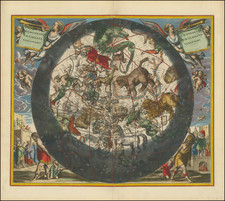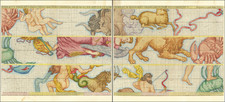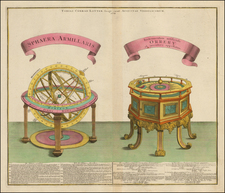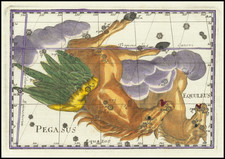A fine old color example of this striking chart of the Northern Sky, illustrating the constellations of the Southern Hemisphere superimposed over the earth's Southern Hemisphere, from Andreas Cellarius's Harmonia Macrocosmica, first published in 1660.
This map is the first state of plate, lacking the plate number in the lower right corner and without the imprint of Valk & Schenk in the title block.
The map provides a fantastic view of the stars. The image is drawn as if seen from deep space, so that each of the constellations is facing in the opposite direction from the way that the same constellations would be seen from earth. This projection reflects a theory that originated with Petrus Plancius that the stars remained in a sphere-like configuration above the earth and moved in coordination with the earth. This theory gives its name to the title of the atlas, Harmonia Macrocosmica.
The Harmonia discussed many other defunct theories of cosmology. This image features in the final section, while previous sections compared Brahe's and Ptolemy's models to Copernicus's and shed light on the newest developments in astronomy. Contemporary astronomers claimed the work was scientifically inaccurate, but later writers applauded the detail of the work and its attractiveness.
The superimposition of constellations directly on to a map of the world is fascinating and makes for an evocative image. The striking drawings of the constellations only add to the attractiveness of this work. Lines of celestial importance are included such as the tropics, polar circles, ecliptic line ("Zodi"), and equinoctal, unifying the stars and the earth.
Around the central image are various earthly and heavenly scenes. Children play around the base of the globe, while knights and learned men gaze at it. Above, cherubs and angels float in a baby blue sky.
This is an extremely attractive and intricate image and a true celestial curiosity.
Andreas Cellarius was born in 1596 in Neuhausen and educated in Heidelberg. He emigrated to Holland in the early 17th century, and in 1637 moved to Hoorn, where he became the rector of the Latin School. Cellarius' best-known work is his Harmonia Macrocosmica, first issued in 1660 by Jan Jansson, as a supplement to Jansson's Atlas Novus. The work consists of a series of Celestial Charts begun by Cellarius in 1647 and intended as part of a two-volume treatise on cosmography, which was never issued.












![[ Crater ]](https://storage.googleapis.com/raremaps/img/small/70467.jpg)

![[ Eridanus ] (Stars Heightened in Gold)](https://storage.googleapis.com/raremaps/img/small/83174.jpg)
![[Children's Astronomy Board Game] Jeu Des Constellations ou Voyage Dans Les Regions Celestes](https://storage.googleapis.com/raremaps/img/small/58616.jpg)